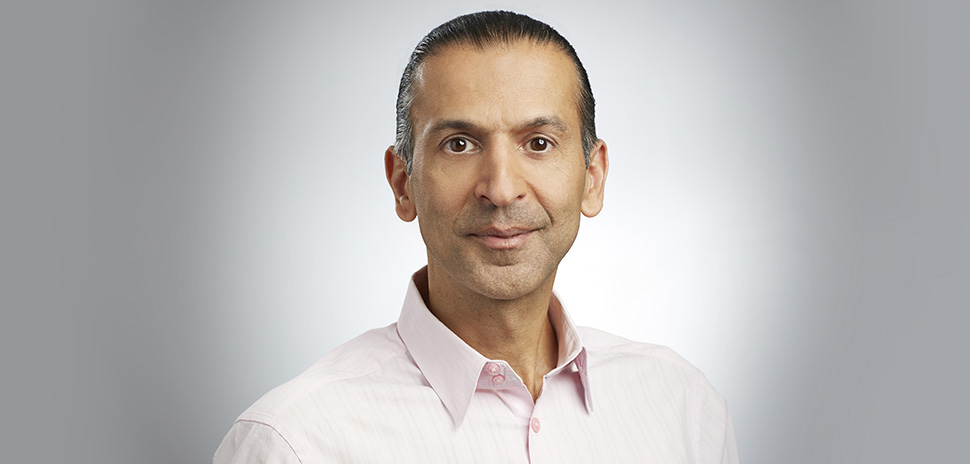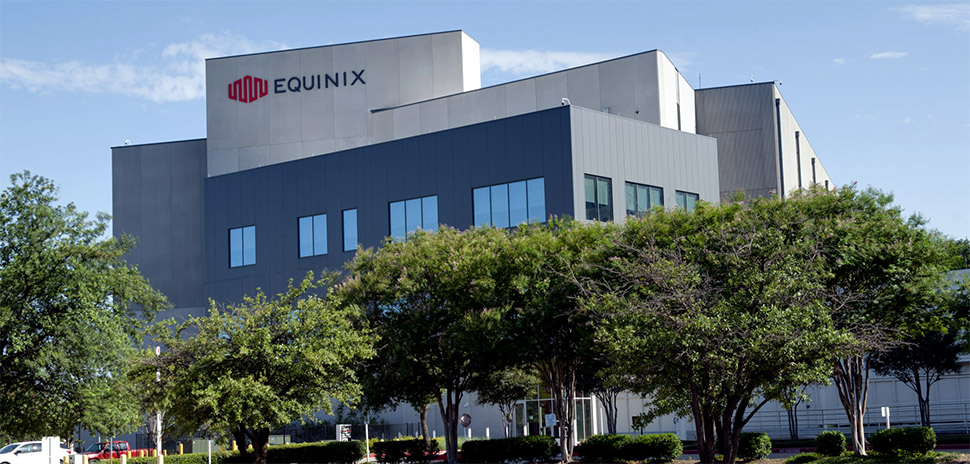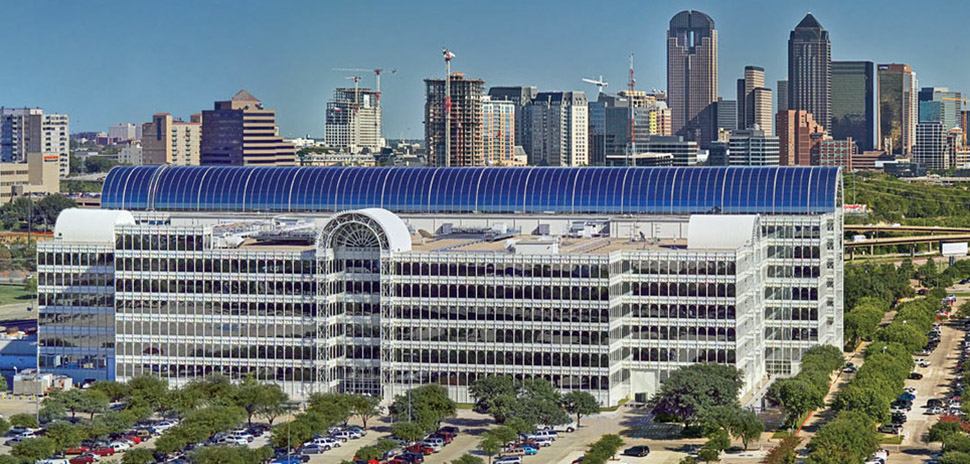Before mobile network operators, cloud platforms, and tech vendors can release 5G and edge solutions, they have to fully test them in the real world. But the “real world” doesn’t always provide the cutting-edge environment these breakthroughs require.
Now there’s a place that does: the Equinix 5G and Edge Technology Development Center (5G ETDC) in the Dallas Infomart.
Digital infrastructure giant Equinix has deployed the development center at its $142 million International Business Exchange data center in the Infomart, located on Stemmons Freeway near downtown. The Redmond, California-based Equinix, a Nasdaq-listed global leader in colocation data centers, calls the development center a “first-of-its-kind technology sandbox” environment.

Justin Dustzadeh [Photo: Equinix]
“As companies develop new 5G technologies and services, they need a real-world environment to test and bring their concepts to life,” said Justin Dustzadeh, CTO of Equinix, in a statement.
The digital infrastructure giant brings to the table an ecosystem of service providers, partners, and clouds making the new 5G ETDC an “ideal place” to fully test concepts, enabling companies to bring “new capabilities to market, accelerate adoption and deliver new revenue streams faster,” he said.
Includes a fully operational Nokia 5G network
The 5G ETDC includes a fully operational, non-standalone 5G network from Nokia to test and validate 5G services and use cases.
Equinix’s goal is to help service providers and network operators bring innovative concepts to market by providing an agile production framework. At the new center, customers can assess, incubate, and test 5G and edge solutions for end-to-end secure applications.
Customers will have “a production-ready interconnection sandbox environment from the radio network to the cloud,” Equinix said, where they can test, demonstrate, and accelerate complex 5G and edge scenarios. The ultimate aim: making 5G deployments available to enterprises in the future.
Dallas Innovates spoke with Jim Poole, a VP in global business development at Equinix — a part of corporate development at the digital infrastructure giant — about details of the new operation and its use-case advantages for companies. Poole, who runs the Evolving Edge program from outside of Washington, D.C., in Virginia, spends his days focused on where the edge will go in the future.
Where is the edge?
Today, large campus environments make up about 99 percent of what Equinix does in some 62 metros around the world. That’s an edge, Poole said — customers who basically put IT infrastructure in those buildings to get closer to their user populations — and it’s been the business model for a very long time.
Poole describes the edge simply: where people and things come together in interconnected devices around the globe. But the future of the edge is something of a moving target.
The edge expert said 5G and private wireless are evolving and unleashing new opportunities for business. Poole also works with subsea cable projects around the world, and increasingly, satellite and aerial frontiers, he said, noting SpaceX and Amazon as transformers in the space.
The new 5G center—which Poole describes as a lab environment—is designed to support the ever-evolving edge.
The tech sandbox

The Equinix DA11 at Dallas’ Infomart [Photo: Equinix]
The 5G ETDC is at DA11 at the Dallas Infomart, one of Equinix’s newest International Business Exchange (IBX) data centers.
Equinix’s new center is composed of two spaces within the building—a space where the majority of the actual equipment is and an indoor radio network centered around the seventh floor of the Infomart.
“It’s big, almost like a ballroom.” Poole said. That’s key for testing: “That empty space allows us to be flexible with how we might test various different scenarios. All the hardware, the equipment that powers the radios connects to the cloud providers, sits inside the data center space within the building.”
Use case testing ground for edge business applications
The scenarios are virtually endless, but the lab focuses on bringing business use cases to life to speed transformation as tech changes rapidly.
Equinix can set up a particular customer environment, such as a shell of a store with video cameras to test video processing as someone takes something off the shelf, walks out of the “store,” and gets charged for it.
Apps and AI are moving to the edge
The first 5G use case client at the center is Exium, a cybersecurity and 5G clean networking company. Exium tested its Secure Edge solution, which enables highly secure, seamless multi-access edge computing functionality from the cloud to edge locations to devices.
“Applications and artificial intelligence are moving to the edge, whether we’re ready or not,” said Farooq Muzaffar, COO of Exium, in a release. The COO said the 5G and Edge Technology Development Center was a key resource for the company and its customers as it incubated, developed, and deployed edge AI services with 5G access.
5G transformation
“The purpose of 5G is to deliver business-quality services over the wireless network,” Poole said. “No one would deploy 5G just for consumers because the differences would be so minor.”

Jim Poole
Poole said all the mobile networks — 1G, 2G, 3G, 4G — are essentially a consumer construct.
“The networks were built originally to deliver voice,” he said. “Then 3G came along, and they overlaid the data, to support FaceTime and text messages—all the other things we do with our smartphones, but they didn’t fundamentally change how the network was built.”
That means all of the traffic that comes in off of the radio networks is essentially dumped into the internet, he said. That’s fine for consumers, who can’t tell the difference between 50 and 100 milliseconds. But 5G is built for business.
The business proposition
5G creates massive possibilities never before possible, Poole said. “If I want to support millions of devices connected over a wireless network or want to support gigabits of throughput, or want a particular class of service, none of those things are possible in 4G and its predecessors,” he explained.
Now it is.
While “that sounds fantastic from a business value proposition, if you start thinking through how a business application living out in the wild somewhere talks to a cloud or private infrastructure—or most likely both, because that’s what normally happens on the wireline side of the equation—how is that going to work?” Poole said.
The edge expert said companies don’t have an answer on how it can all work end to end. That’s where the Evolving Edge and Equinix’s new center comes in, according to Poole.
The 5G roll out—which will take several years—is an opportunity to lead the way in demonstrating how things like hybrid cloud and multi-cloud applications capabilities can be delivered over a 5G network.
Connecting pipelines of possibility
The business dynamic for 5G creates “a giant chicken and egg” problem, Poole said. “Theoretically, because of this technology, all types of things should be possible—things we’ve never had the capability to do.”
But customers need help with those possibilities—what it costs and how it works. Equinix, which Poole calls “layer zero” in the OSI tech model, and its new lab can turn the abstract into reality, he said.
Equinix, with its customer base of mobile and wireline cloud companies as well as large enterprises, has spent 22 years as a digital connector helping enterprises coordinate resources between very different domains, running servers, and storage.
“What most people don’t appreciate is that it’s not a trivial or simple thing, making a radio network talk to any cloud provider or any private IT infrastructure with quality of service,” he said. There’s a real physical incarnation of how things need to be wired together.
“It sounds beautiful and simple,” Poole said. “And the reality is, it takes angels dancing on the head of a pin.”
The human factor
The people who run the network are different than the people who run the wireless networks, Poole said.
But to create an autonomous vehicle drone or AR/VR application, for example, people who have never worked together within an organization need to collaborate. “I see this all the time: People who now suddenly are put into the same business unit, the same group, and they’ve got to figure out how to make all this work,” Poole said.
Equinix’s “tech sandbox” is designed to help connect the internal experts and facilitate the transformation 5G and other technology offers to companies through different use cases.
The new center is an extension of Equinix’s history of running “solutions validation centers.” In its data centers around the world, Equinix maintains a number of racks that sit empty for customers tests.
“If a customer were to come to us and say, how would I take Amazon, Google, Facebook, Verizon, AT&T and combine them to all work on components that sit inside of your building, we maintain a space so that a customer can literally just roll their stuff in and test it,” Poole said.
The new Dallas center can be thought of “as kind of the top of the heap” in terms of having the most capabilities for testing the widest set of scenarios, Poole said. “We control all of the pieces.”
‘Four horsemen of the Internet’
The choice of Dallas as a market was purposeful, Poole said.
Equinix, which bought Infomart Dallas in 2018 in an $800 million deal, has since expanded both in and outside of the building. Equinix bought all of the property associated with the Infomart, and the newest site it deployed for additional capacity was essentially on what was once the parking lot. “It’s one big campus, basically,” said Poole.
He describes the Infomart as one of the most interconnected building in the South Central United States. Poole notes the large number of tech companies and major telcos with significant development facilities in and around the Dallas-Fort Worth region.
“It’s an ideal place to stand up this kind of environment because of all of the interested parties that, generally speaking, have operations in Dallas,” he said.
Poole calls Dallas one of the “four horsemen of the Internet,” along with D.C., the Bay area, and Chicago. “That has to do with the legacy of how the Internet was built with the first big giant interconnect points and so these markets have got the most gravity.”
Why Dallas?
Choosing Dallas for the new center made sense with demographic trends, Poole said. “Dallas is a very attractive place to attract engineering talent, because people want to live where it’s nice, and it’s less expensive,” he said.
He sees a movement of technology development resources to the South because people like the weather, among other things.
The tech talent universe is pretty diverse, and “when we look at the big tech companies and the big operators, and the big cloud companies that we do business with, it’s not that they’re not also in other metros, but they’ll put their big conglomerations of people in the Dallas region,” he said.
Beyond the level of talent, places like Dallas tend to be attractive for testing things in the wireless context. It’s a “nice, flat, environment for radio propagation characteristics” and for metro testing.
Real-life components
Equinix wants enterprises and service providers to understand what’s available and plans to show how their products and services can work. “We want them to make money and jointly show the world what’s possible—how easy it is to do,” Poole said.
“One unique factor of the new lab is that it connects to production networks, AWS, Oracle, Azure, Google, you name it,” he said. They’re all in that building.” While there are other labs, most of those operator labs don’t attach to public resources, he adds.
The production fabric is Equinix’s SDN-enabled interconnect. Its production network edge, the NFV platform and production bare metal, all exists in that area, he said.
Other than the radio network, which is private to the building, everything else is production service. That’s “very unique from a lab perspective,” he said. “Most labs tend to be just—in the lab where it works great—and then you leave the lab and you’ve got to rebuild in a completely different way.”
“The reality is, 90 percent of the components are actually real-life components that live in every single one of our metros so anything that we show, we can replicate relatively easily,” he said
Lab-type environment
The digital infrastructure giant will also use the center for its own releases at the forefront of technology. The center is essentially a lab-type environment run in conjunction with Equinix’s CTO organization, which will explore tech development. Equinix wants to “lead the way” and help operators understand how to make new tech viable and an attractive monetization mechanism.
Initially, the Equinix 5G and Edge Technology and Development Center will focus on use cases for mobile hybrid multi-cloud connectivity, network slicing, distributed artificial intelligence and machine learning, enablement, and orchestration of infrastructure, augmented and virtual reality, and gaming.
5G Network Slicing ‘released in the wild’
With the new lab, Equinix plans to release a new, novel technology from a radio perspective that’s unique to 5G called Network Slicing. To oversimplify, the tech enforces a QoS layer on the radio network and eventually connects to an application, Poole said.
“It’s the first time Network Slicing has ever been released in the wild, and there’s a lot of interest from corporations on how to use it, and some uncertainty, for example, on how you take a network slice in Dallas and map it to a private cage in a public cloud,” Poole said.
Those types of interconnection questions are exactly the things the company spends time on the wireline side of the business as the “world’s biggest interconnection provider, bar none,” Poole said.
Nokia IP solutions underpin what’s called Equinix Fabric, which can provide a seamless interconnection between global data centers.
That interconnection is crucial, said Sean Hemphill, VP of webscale business at Nokia, who believes the way IP traffic moves between networks around the world will change completely with 5G.
Interconnection answers
Equinix does “hundreds of thousands” of interconnects between counter parties in its facilities, and the new center focuses on the 5G version of that. Multi-domain orchestration is key, said Poole.
Many applications run across multiple different domains: a piece might run in a public cloud, on a private server, and connect to two different networks, for example.
Solving for the coordination of different domains is “something that on the wireline side we do a lot. But on the wireless side, it’s a unique environment,” Poole said.
Equinix works not only on “how do you make it work, but how do you do it on an automated, on-demand basis,” he said.
“People want instantaneous satisfaction.”
Kick 5G tires
5G opens up massive possibilities across industries, and Poole wants people and companies to explore those through the new lab. With applications for most any business, the technology can create opportunities that would have been impossible or too expensive until now.
“People just don’t believe it’s happening, because they’ve heard it, but yet they don’t notice any difference,” he said.
“The easiest way to convince people that you know something is possible is just to show it to them. And so, you know, people shouldn’t be afraid. People should come out and kick the tires.”
![]()
Get on the list.
Dallas Innovates, every day.
Sign up to keep your eye on what’s new and next in Dallas-Fort Worth, every day.





































































